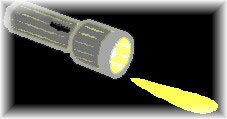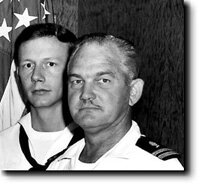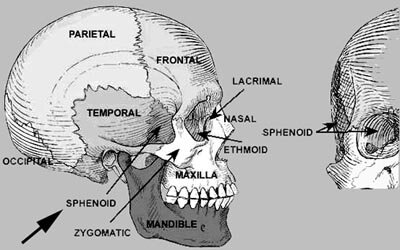 Dark Corners Menu |
 Pitzer Main Page |
 Dark Corners Menu |
 Pitzer Main Page |
by Allan Eaglesham
| Lieutenant Commander William Bruce Pitzer died of a gunshot wound to the right temple on October 29, 1966, at the National Naval Medical Center, Bethesda, MD. Here are described seven aspects of the evidence indicating that he was murdered. |
 Harold Rydberg & William Pitzer (Courtesy of Harold Rydberg) |
|
A LINK WITH THE ASSASSINATION OF PRESIDENT KENNEDY
William Bruce Pitzers name entered Kennedy-assassination lore on May 1, 1975. An article in the Waukegan, IL, News-Sun -- Another Link in JFK Death? -- stated: A Navy technician who filmed the autopsy of President John Kennedy may have been an early victim of a mysterious death syndrome that has been a bloody footnote to the assassination&The death of the technician, Lt. [sic] William Pitzer, should be an early addition to that list, believes a Lake County man who worked at Bethesda (Md.) Naval Hospital in 1963. The Lake Countian doesnt want his identity made public& "He was shot with a .45-caliber pistol and was found with the gun in his right hand," he said. "But he was left-handed. If he would have used a weapon he would have used his left hand." The technician had filmed in detail the Kennedy autopsy. Just before he was due to retire, ending 28 years in the service, he was found dead. "Ive always believed he was murdered," the former hospital worker said. As a result of this link with the Kennedy autopsy, William Pitzers death has been mentioned in many books on the assassination including Jim Marrs' Crossfire (Carroll & Graf, 1989) in a chapter titled Convenient Deaths and in High Treason by Robert Groden and Harrison Livingstone (Conservatory Press, 1989). The Pitzer case merits a three-page section in Livingstone's High Treason 2 (Carroll & Graf, 1992) and a whole chapter is devoted to it in his e-book, Stunning New Evidence in the JFK Case [http://www.harrison-e-livingstone.com/ jfk/].
In High Treason 2, the Lake County man -- now identified as Dennis David -- is quoted (as in the News-Sun article) as saying that "close friend" William Pitzer was left-handed. And in a statement preliminary to the chapter on the Pitzer case in Stunning New Evidence, Mr. Livingstone attributes the following to Mrs. Pitzer: He couldnt have committed suicide. There was no reason for it, and he had a lot to look forward to...his left hand was the hand that he would have pulled the trigger with. It seems unlikely that a left-handed man would shoot himself in the right temple.
These items of evidence were reported and discussed in articles published in JFK/Deep Politics Quarterly [1-3]. Most strongly indicative of murder is the report by US Navy Medical Examiner Robert Steyn -- who saw the body -- that Pitzer sustained a bullet wound to the left temple: The motionless, fully dressed body was [illegible] with the left arm flexed and right arm under the abdomen. A left temple wound was visible, the right side of the head being hidden, lying against the floor in a pool of coagulated blood. [emphasis added] Apparently consistent with this report, the cover page of the autopsy report describes three defects in the skull: Puncture wound, skull, right temporal bone (entrance) [*Author's note: within the autopsy report the exit wound is located above and slightly behind the left ear.] In large part, the sphenoid bone constitutes what is commonly known as the temple (Figure 1). 
Figure 1. Location of the sphenoid bone
After removal of the brain, a third defect in the bony skull is encountered. This consists of a large defect in the left-supraorbital plate measuring 3.0 x 1.0 cm. This third hole in the skull bone, running from the left-supraorbital plate into the sphenoid bone, had no corresponding skin lesion at the left temple, neither did it have a corresponding lesion to the underlying brain. Puzzling. Another aspect indicative of homicide was the description of the entry wound by the autopsists. When interviewed by an FBI agent after completion of the postmortem examination, autopsy doctor LCDR J.G. Harmeling stated that the muzzle of the revolver had not been in contact with the skin at discharge, nor did he find powder burns around, or powder particles imbedded in, the entry wound in the right temple. The autopsy report describes an area of "charring" around the wound that may be interpreted as a margin of soot deposit, yet the report described the skin around the entry wound as having "no deposits of foreign material." LCDR H.B. Lowsma, who assisted in the autopsy, told the FBI: (T)here was no evidence of powder burns on the right side of the head where entry was made& (He) explained that he could not say how far from the head the gun was held as he was no expert in this field. At the request of the navy, the FBI conducted laboratory tests that showed that the revolver must have been held at a distance of three feet or more to preclude powder burning of the skin. Two entry wounds to the head, one to the right temple from a distance of at least three feet and one to the left temple (through the sphenoid bone) would be highly indicative of homicide. Another aspect indicative of homicide was the fact that the revolver found at LCDR Pitzers side did not bear his fingerprints. Another aspect indicative of homicide was the fact that paraffin tests of Pitzers right palm and back of hand were negative, indicating no contact with a discharged firearm. An FBI report sent to the Naval Investigative Service, dated December 14, 1966, stated: Examination of (the) paraffin cast reflected no substance characteristic of, or which could be associated with, gunpowder or gunshot residue. Another aspect potentially indicative of homicide was the question of the trajectory of the fatal bullet. A movable blackboard in the TV studio was "located near the body." It was struck by a bullet, as revealed by analysis of residual metal particles in an indentation: ...possible [sic] by the projectile after passage through the skull of the deceased. Apparently, this was a source of puzzlement for the investigating officers; given the locations of the corpse, revolver, spent bullet, and blackboard, there had to have been another point of ricochet: Extensive examination of the scene failed to determine what the projectile struck resulting in the extensive indentation. Another aspect, indicative of foul play, was the suggestion that William Pitzer's left hand was injured. In a telephone conversation [4], Mrs. Pitzer said: They couldnt give me the wedding ring because they said his left hand was damaged&that they never were able to explain. This conjures up an image of a struggle with Pitzer fending off blows or of being struck by a bullet as he thrust out a hand in a defensive reaction.
I made contact with William Pitzer's son Robert in June of 2000, and immediately suggested that, by means of a FOIA request, he attempt to obtain possession of the photograph taken at the scene that I knew was held by the US Navy Office of the Judge Advocate General (JAG) [3]. (My request for a copy of this photograph had been denied because of lack of familial ties with the deceased. A formal request to view the photograph at the JAG Office had been similarly denied.) Mr. Pitzer obtained the photograph and provided me with a copy (Figure 2). |
|
| The monochrome 8x10 is a poor-quality scan with excessive contrast. The camera was about 18 inches from the floor and about 6 ft from the body; the left side is towards the camera, visible to the upper thigh. He is prostrate, lying on his right arm with fingers partially visible at the hip. The left arm is flexed with the hand close to, possibly touching, the mouth. The left side of the face is visible to the left nostril. The left shoulder obscures the lower part of the cheek to the left earlobe. The upper part of the head, from approximately the auricular canal, is under an aluminum stepladder. Blood is spattered on the upper surface of the lowest step, and is smeared on the vertical surface. The head is right-side down in a pool of blood. |

Figures 2 and 3. The death scene. |
|
A striking aspect is the profuse spatter of blood on the floor between the body and the camera. The floor locations of legs of a chair that had been removed for the photograph are visible as chalk marks, as is the outline of the revolver to the extreme lower right. It appears that blood is oozing from two contiguous oval areas at the left temple (Figure 3); one narrow trickle of blood passes over the left cheek onto the upper lip and is then obscured by the left hand, and the other narrow trickle of blood from the left temple goes over the left eyebrow, onto the nose and then is obscured by shadow. From above the left ear to the forehead is a broad tract of blood; also, there is a broad tract of blood behind the left ear. The origin of these broad tracts is not obvious, but presumably they come from the exit wound, stated in the autopsy report to be in the hair above and slightly behind the left ear.
In August, 2001, I took the photograph to Herbert L. MacDonell, Professor of Criminalistics and Director of the Laboratory of Forensic Science, Corning, NY. Professor MacDonell examined it along with an enlargement of the head area. He was not surprised when told that the subject had been found to have committed suicide. However, he was surprised when I said that, officially, the subject had committed suicide by shooting himself in the right temple. Professor MacDonell had concluded from his viewing of the photograph and the enlargement that there was a bullet wound in the left temple. Bullet wounds in both temples would be highly indicative of homicide. |
|
|
[1] Eaglesham, A.R.J. and Palmer, R.R. (1998) The Untimely Death of Lt. Cmdr. William Pitzer. JFK/Deep Politics Quarterly 3(2) 6-16. |
|
 Dark Corners Menu |
 Pitzer Main Page |
![]()